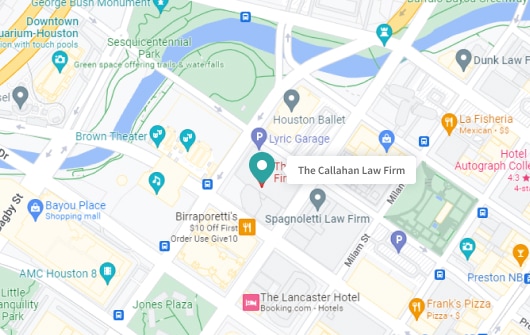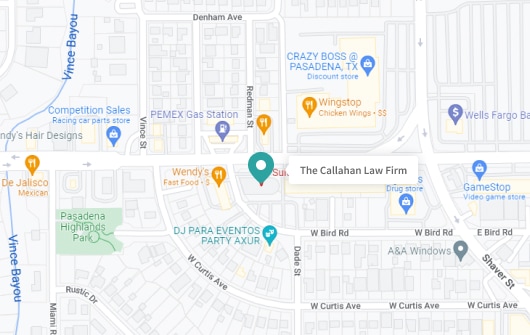What is a ‘Laceration Personal Injury’?

Lacerations, commonly referred to as cuts or tears in the skin, are one of the most common forms of personal injury encountered in various types of accidents. These injuries can range from minor cuts requiring basic first aid to severe wounds necessitating professional medical treatment. Whether minor or major, laceration injuries have the potential to lead to significant physical, emotional, and financial consequences for the affected individuals.
For those injured by someone else’s negligence, understanding the nature of these injuries and how they happen can help you take care of your health and deal with any legal process that may follow.
As you navigate the complexities of recovery and legal proceedings following a laceration injury, know that you do not have to face this journey alone. The Callahan Law Firm is here to provide you with the support, guidance, and legal representation you need to secure the compensation you rightfully deserve. Contact us today to schedule a no-cost consultation.
Understanding Lacerations
Lacerations are skin cuts typically caused by blunt trauma. Unlike incisions or cuts made by sharp objects, lacerations tend to have irregular, jagged edges and are often accompanied by bruising and tearing of the skin and underlying tissues. Depending on the force and nature of the trauma, these injuries can vary in depth and severity, impacting not just the skin but also muscles, nerves, and blood vessels.
The implications of lacerations extend beyond the immediate physical damage. In some cases, individuals may experience long-term physical pain or disability. This is particularly true for deep lacerations that affect nerves or lead to significant scar tissue formation, which can result in reduced mobility and pain in the affected area. The healing process can be prolonged and complicated, requiring medical interventions such as stitches or surgery and physical therapy to restore function.
Determining the causes of laceration accidents is crucial for several reasons. First, understanding how the injury occurred can help medical professionals provide the most appropriate treatment and advice for preventing future injuries. Additionally, from a legal perspective, identifying the cause of the injury is essential for personal injury claims.
Lacerations resulting from accidents due to negligence may entitle the injured party to compensation. Establishing the cause is the first step in holding the responsible parties accountable and ensuring that the injured party receives the necessary support for recovery and rehabilitation.
Common Causes of Laceration Accidents
Laceration accidents can occur in a wide range of scenarios, each presenting unique risks and challenges. Understanding these common causes is crucial for prevention and ensuring appropriate measures are in place to protect individuals in various environments. Some of the most common causes include:
- Workplace Accidents: The workplace is one of the most common settings for laceration injuries, particularly in industries involving the use of machinery, tools, and equipment. Manufacturing, construction, and culinary sectors see a high incidence of such accidents due to the interaction with sharp objects, heavy machinery, and potentially hazardous working conditions.
- Car Accidents: Car accidents are significant contributors to laceration injuries. Broken glass, metal fragments, and the sheer force of impact can cause deep cuts and wounds.
- Assaults: Unfortunately, assaults are also a cause of laceration injuries. Violent encounters involving sharp objects or blunt force can result in severe and sometimes life-threatening cuts, underscoring the serious implications of personal and public safety.
Among the various types of laceration injuries, those involving the hands are particularly frequent. This prevalence is due to the hands’ active involvement in most daily activities and work-related tasks, which exposes them to potential harm. Hand lacerations not only cause immediate pain and discomfort but can also lead to long-term issues such as impaired hand function, reduced grip strength, and sensitivity, particularly if tendons or nerves are damaged.
For those affected, understanding the cause and context of the injury is essential in seeking appropriate medical care and legal recourse, especially if the accident resulted from someone else’s negligence.
Negligence and Laceration Accidents
Negligence is a fundamental concept in personal injury law, and that includes cases involving laceration accidents. Establishing negligence is critical in determining fault and liability, as it demonstrates that the injury resulted from a party’s failure to act with reasonable care.
In the context of laceration accidents, proving negligence involves showing that the responsible party had a duty to ensure safety, breached that duty, and that the breach directly caused injury, leading to damages. The following are some examples of negligence that lead to laceration incidents:
- Distracted Driving: A driver not paying attention to the road, perhaps due to texting or using a phone, can easily cause a car accident. The resulting collision can lead to broken glass and sharp metal causing laceration injuries to occupants. Distracted driving is a clear example of negligence, as drivers have a duty to remain alert and focused to prevent causing harm to others on the road.
- Failure to Provide Safe Equipment: In workplaces, especially in sectors like manufacturing, construction, and the culinary industry, employers are required to provide safe, well-maintained equipment and protective gear. When employers neglect this duty, and an employee suffers a laceration from a malfunctioning piece of equipment or lack of proper safety tools, any resulting lacerations could be from the employer’s negligence.
- Failure to Maintain Safe Premises: Property owners and managers have a responsibility to ensure their premises are safe for visitors. This includes regular maintenance to prevent hazardous conditions. For instance, a customer sustaining a laceration injury from a broken shelf or exposed sharp edge in a store could indicate negligence on the part of the owner for failing to address a known hazard.
Proving negligence is essential for injured parties seeking compensation for their injuries, medical expenses, lost wages, and other damages. Demonstrating the other party’s negligence establishes liability and validates the injured party’s claim for compensation. Building a compelling case requires collecting evidence such as eyewitness testimony, accident reports, photos of the accident scene, and expert opinions.
Types of Laceration Injuries
Laceration injuries are among the most common types of injuries encountered in both everyday life and more hazardous environments. The most common types include:
- Superficial Lacerations: These are minor cuts affecting only the skin’s surface. While they may not require stitches, proper cleaning and care are essential to prevent infection. While superficial lacerations typically have minimal long-term effects, the cost of the initial medical consultation and follow-up can add up, especially if infection occurs.
- Deep Lacerations: These cuts extend beyond the skin to muscles, tendons, or bones. They often require stitches or surgery to close and heal correctly. Deep lacerations carry a risk of long-term effects, including loss of function, significant scarring, and nerve damage. The need for specialized medical care and potential rehabilitation means these injuries can be costly.
- Clean Lacerations: Characterized by smooth edges, clean lacerations are often caused by sharp objects. Though potentially deep, their “clean” nature may simplify treatment and reduce infection risks. However, even clean cuts can require significant medical attention if they are deep, increasing healthcare expenses.
- Complicated Lacerations: These injuries involve not just a cut but also damage to underlying structures, such as nerves, blood vessels, or bones, and may be contaminated with debris. Complicated lacerations require extensive medical intervention, possibly including surgery, to address all aspects of the injury. They are associated with high treatment costs, a prolonged recovery period, and a greater likelihood of long-term complications.
Each type of laceration injury necessitates prompt medical attention to prevent complications and ensure proper healing. Understanding these different types of lacerations underscores the importance of seeking immediate care and the potential financial impact of these injuries.
Filing a Laceration Accident Lawsuit
Navigating the aftermath of a laceration accident involves not just medical recovery but also understanding one’s legal rights and options. For those considering a laceration accident lawsuit to seek compensation for their injuries, the process involves several critical steps.
- Gathering Evidence: The foundation of a successful laceration accident lawsuit lies in the evidence. This includes medical records detailing the extent of the injuries, photos of the accident scene, eyewitness statements, and any other documentation that can prove negligence on the part of another party.
- Understanding the Statute of Limitations: It’s crucial to act within the legal time frame for filing personal injury lawsuits regarding lacerations, known as the statute of limitations. For most types of personal injury claims in Texas, the general deadline is two years.
- Hiring Skilled Legal Representation: While it’s possible to navigate the legal system independently, the complexity of personal injury law and the challenges of negotiating with insurance companies make skilled legal representation highly beneficial.
Some of the primary benefits of working with a lawyer include:
- Experience and Knowledge: An experienced lawyer understands the nuances of the law and how to navigate the legal system effectively.
- Negotiation Skills: Attorneys are skilled in negotiating with insurance companies and opposing counsel to secure fair compensation.
- Maximizing Compensation: Legal professionals know how to accurately assess the full extent of damages, ensuring that you receive compensation that reflects the true cost of your injuries, including future medical expenses and non-economic damages like pain and suffering.
- Peace of Mind: Having an attorney handle the legal aspects of your case allows you to focus on recovery, knowing that your rights are being protected.
Filing a laceration accident lawsuit involves careful preparation, timely action, and often the support of a legal professional. By understanding these key elements, injured parties can take important steps toward securing the compensation they need for their recovery.
Compensation for Laceration Accident Lawsuits
In successful laceration accident lawsuits, compensation awarded to injured parties is intended to cover the wide range of losses and damages they have endured. This compensation is critical in helping them rebuild their lives and address the various challenges that arise from their injuries. The types of damages that may be recovered can include:
- Medical Expenses
- Lost Wages
- Pain and Suffering
- Mental Anguish
- Loss of Ability or Functionality
The amount of compensation you may be entitled to directly correlates with the severity of the laceration injury and its long-term impacts. An experienced attorney can help navigate the complexities of the legal process and advocate for the maximum compensation possible, considering the unique circumstances of each case.
Contact The Callahan Law Firm Today
Navigating the aftermath of a laceration accident can be an overwhelming experience, marked by physical recovery, mental anguish, and financial uncertainty. It is crucial for injured parties and their families to understand their rights and the legal options available to them. Recognizing the potential for compensation through a lawsuit can offer a pathway to alleviating some of the burdens associated with these injuries.
The Callahan Law Firm is ready to help those in need of legal assistance. Our team of experienced laceration personal injury attorneys handles laceration accident cases, offering personalized support and committed representation to ensure you receive the compensation you deserve. Don’t navigate this journey alone; contact us today to schedule your no-cost consultation.
FAQ:
What type of injury is a laceration?
A laceration is a type of injury characterized by a deep cut or tear in the skin or flesh, often resulting from blunt trauma. Unlike a simple cut, lacerations are typically more jagged and may involve deeper layers of skin and tissue.
What is the legal definition of a laceration?
A laceration is considered a bodily injury that involves a break in the skin resulting from an external force or impact. This definition is often used in laceration personal injury cases to describe the physical evidence of harm suffered by an individual.
What are the consequences of a laceration?
The consequences of a laceration can be minor, requiring basic wound care, or severe, necessitating medical intervention such as stitches or surgery, and can lead to infections, scarring, or even long-term disability. They can also have significant emotional and financial impacts on the victim.
What is the difference between a tear and a laceration?
The terms “tear” and “laceration” are often used interchangeably in a medical context to describe an injury involving a break in the skin.












